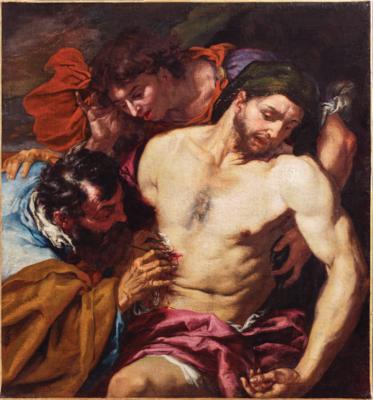Giovanni Battista Langetti
(Genoa 1635–1676)
The Good Samaritan,
oil on canvas, 104 x 97 cm, framed
Provenance:
Private collection, Paris;
sale, Artcurial, Paris, 19 June 2012, lot 25 (as Giovanni Battista Langetti);
Private European collection
Literature:
M. S. Mantovanelli, Giovanni Battista Langetti: il principe dei tenebrosi, Soncino 2011, p. 185, no. 74, fig. 51 (as Giovanni Battista Langetti)
The painting depicts the story of the Good Samaritan, told in the Gospel of Luke 10:29–37: a man travelling from Jerusalem to Jericho is attacked by some thieves, who strip and beat him. A priest and a Levite pass by without helping the victim, but a Samaritan stops and takes the man to an inn, paying for his care. The subject was handled by Langetti on various other occasions, according to his frequent habit of revisiting motifs: a similar composition is held in the Harrach Collection, Vienna (inv. no. 519) and other versions can be found in the Holburne Museum in Bath and the Musée des Beaux-Arts in Lyon; the Fototeca Zeri also holds the image of a canvas depicting The Good Samaritan in a private Milanese collection (no. 59190).
Langetti’s manner of painting is consistent throughout the course of his brief career, and it is characterised by the great speed of his dense brushwork together with a tendency to use a dark palette. In his compositions, importance is given to the nude figure, as well as to an intensity of expression and gesture. His usual choice of positioning the figure’s torso on the diagonal invites the viewer to look beyond the picture plane, conferring vitality and dynamism to his images.
Giovanni Battista Langetti’s earliest training took place in his native city of Genoa, he completed his apprenticeship in Rome in the studio of Pietro da Cortona. He travelled to Naples where he came in contact with various painters influenced by Caravaggio, most notably Jusepe de Ribera. From the latter half of the 1650s he established himself definitively in Venice without loosing contact with his native Genoese ambient. Boschini described the painter as ‘a tenebrist and dark genius’ (see M. Boschini, La Carta del Navegar pitoresco, 1660, ed. by A. Pallucchini, Venice/Rome 1966, p. 577) on account of his painterly style, which drew him into association with other painters active in Venice at the time whose work is characterised by extreme naturalism and a dramatically violent deployment of light and shade.
Esperto: Mark MacDonnell
 Mark MacDonnell
Mark MacDonnell
+43 1 515 60 403
old.masters@dorotheum.com
25.10.2023 - 18:00
- Prezzo realizzato: **
-
EUR 117.000,-
- Stima:
-
EUR 40.000,- a EUR 60.000,-
Giovanni Battista Langetti
(Genoa 1635–1676)
The Good Samaritan,
oil on canvas, 104 x 97 cm, framed
Provenance:
Private collection, Paris;
sale, Artcurial, Paris, 19 June 2012, lot 25 (as Giovanni Battista Langetti);
Private European collection
Literature:
M. S. Mantovanelli, Giovanni Battista Langetti: il principe dei tenebrosi, Soncino 2011, p. 185, no. 74, fig. 51 (as Giovanni Battista Langetti)
The painting depicts the story of the Good Samaritan, told in the Gospel of Luke 10:29–37: a man travelling from Jerusalem to Jericho is attacked by some thieves, who strip and beat him. A priest and a Levite pass by without helping the victim, but a Samaritan stops and takes the man to an inn, paying for his care. The subject was handled by Langetti on various other occasions, according to his frequent habit of revisiting motifs: a similar composition is held in the Harrach Collection, Vienna (inv. no. 519) and other versions can be found in the Holburne Museum in Bath and the Musée des Beaux-Arts in Lyon; the Fototeca Zeri also holds the image of a canvas depicting The Good Samaritan in a private Milanese collection (no. 59190).
Langetti’s manner of painting is consistent throughout the course of his brief career, and it is characterised by the great speed of his dense brushwork together with a tendency to use a dark palette. In his compositions, importance is given to the nude figure, as well as to an intensity of expression and gesture. His usual choice of positioning the figure’s torso on the diagonal invites the viewer to look beyond the picture plane, conferring vitality and dynamism to his images.
Giovanni Battista Langetti’s earliest training took place in his native city of Genoa, he completed his apprenticeship in Rome in the studio of Pietro da Cortona. He travelled to Naples where he came in contact with various painters influenced by Caravaggio, most notably Jusepe de Ribera. From the latter half of the 1650s he established himself definitively in Venice without loosing contact with his native Genoese ambient. Boschini described the painter as ‘a tenebrist and dark genius’ (see M. Boschini, La Carta del Navegar pitoresco, 1660, ed. by A. Pallucchini, Venice/Rome 1966, p. 577) on account of his painterly style, which drew him into association with other painters active in Venice at the time whose work is characterised by extreme naturalism and a dramatically violent deployment of light and shade.
Esperto: Mark MacDonnell
 Mark MacDonnell
Mark MacDonnell
+43 1 515 60 403
old.masters@dorotheum.com
|
Hotline dell'acquirente
lun-ven: 10.00 - 17.00
old.masters@dorotheum.at +43 1 515 60 403 |
| Asta: | Dipinti antichi |
| Tipo d'asta: | Asta in sala con Live Bidding |
| Data: | 25.10.2023 - 18:00 |
| Luogo dell'asta: | Wien | Palais Dorotheum |
| Esposizione: | 14.10. - 25.10.2023 |
** Prezzo d’acquisto comprensivo dei diritti d’asta acquirente e IVA
Non è più possibile effettuare un ordine di acquisto su Internet. L'asta è in preparazione o è già stata eseguita.

